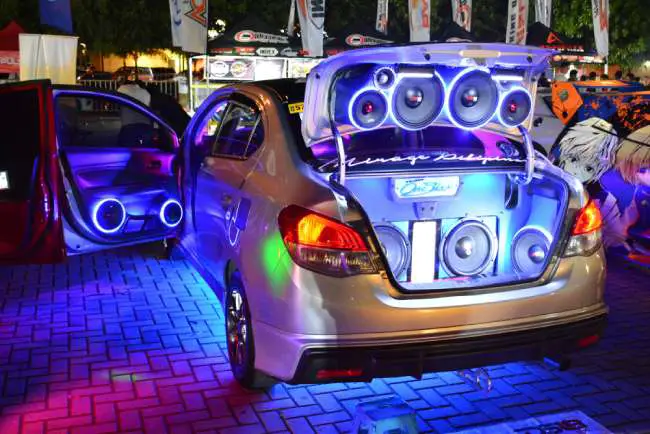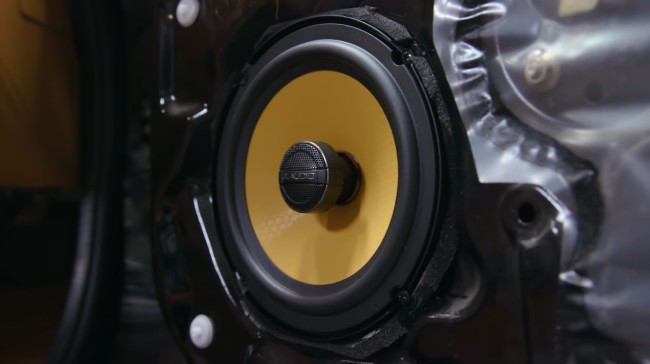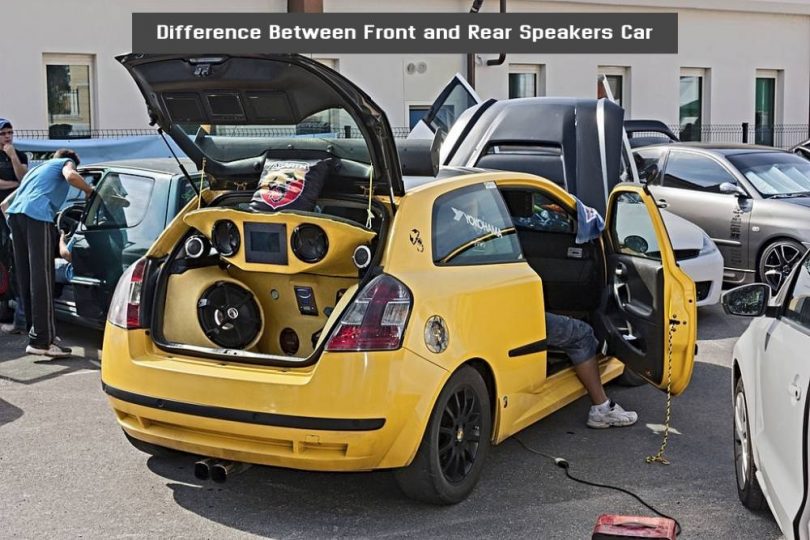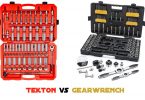Front speakers optimize high-and mid-range audio frequencies and audio in dialogues. This helps hear the character lines in the media you’re streaming.
On the other hand, rear speakers work on low-frequency and mid-range audio that fills in the gap for a robust sound.
Let’s get to know more about their differences.
Front and Rear Speakers: What Are the Differences?
Front stage vs rear fill
Usually, when you listen to music at home or at a concert, the majority of the sound comes from directly in front of you. That’s because front speakers determine the sound staging.
What that means is, a good pair of front speakers can make you think the artists and instruments are surrounding you. That’s why front speakers act as the primary source of the sound.
Finding good front speakers is a top priority to achieve fine sound quality. We recommend that you dedicate the lion’s share of your budget here.
Size of speakers
The space between your car is limited. That’s why you need to consider the speaker size before you continue your search. Keep track of the original speakers of your vehicle.
However, If you are okay with extreme modifications like cutting into a door panel, you can use adapters and spacer rings to expand the front and back speakers.
The size of the speaker determines how much bass it produces, especially if you don’t have a subwoofer. Remember, the larger your speakers, the more power they’ll need.
We recommend that you choose the largest speakers you can afford and fit in your car, even if you have a subwoofer. This will reduce the perception of low frequencies coming from the rear.
Coaxial and component speakers
You get tweeters and woofers separately with component speakers. It also divides the frequencies better through superior crossovers to provide you fine quality sound.
Many vehicles have component speaker slots, you can spot them by a small speaker grill, usually located just above the dash or on the door.
When installed correctly. component speakers can offer you better power handling and tonal clarity that’ll outperform your home sound system.
Coaxial speakers need less power than the default speakers. They usually come with a built-in tweeter, woofer, and a simple crossover.
Coaxial speakers are ideal for quick speaker replacements and are compatible with almost every vehicle. If money is a big concern, they can help to get better sound at low cost.
Power efficiency and power handling
You also need to consider the electronic components that will power your speakers. Most high quality speakers consume more power than your average in-dash radio.
Look at the Speaker efficiency ratings. This will help you to learn how much power you’ll need to achieve a certain sound pressure level. The higher the decibel number is, the more efficient your speakers will be.
The majority of coaxial speakers consume less power. However, top-quality stand-alone amplification gives you more detail and less distortion.
Don’t forget to check the wattage rating (power-handling rating) to find the best speakers with low power consumption.
How Do You Match Front and Rear Car Speakers?

Install the Same Speakers
It is always a good idea to choose both front and rear speakers from the same manufacturer. That way, you can easily avoid annoying pitch differences.
If your vehicle is equipped with a video entertainment system, the rear fill can have a major impact on creating surround sound.
Different brands manufacture their products differently. That is why there is a possibility where the sound waves from both speakers collide, creating uneven tonal quality and noise.
If you are looking for identical sounds, choose the same brand for both front and rear speakers of your car. Get the front one first, then you can upgrade your system however you like.
Match sensitivity
If you want to enjoy a clean surrounding-sound system, your front and back speakers need to be as near to the sensitivity level as possible. Otherwise, the front speaker will produce sounds too loud while the rear speakers will become quiet, making the overall sound dull.
For example, with front speakers that have a sensitivity level of 100dB, the rear speakers can be expected not to be lower than 99dB.
Match Speaker Power
Power handling means how much power your speaker can handle at once. Both pairs should be similar/close to each other in wattage.
If you want better tonal clarity and even sound distribution, we recommend you use speakers that are close in wattage. It doesn’ matter if you already have an external amplifier or not.
It is not very practical to have 150W speakers in the front and 50W speakers in the back. That way, you won’t be able to hear anything coming from the rear speakers.
Match Frequency
The frequency of the rear speakers should be lower than that of the front ones. We recommend you let your rear speakers deal with all the lower frequencies.
That way, you’ll be able to enjoy the best quality stereo effect within your car.
Front speakers are usually made in a way they can handle much higher frequencies. Once you get that part covered, Leave the high beats to your front speakers. The rear ones are there to compliment the sound.
Don’t forget, rear speakers work better with lower frequencies.
How Many Speakers Are Enough for Your Car?
I’m sure you remember me saying your car has limited space. That’s why it would not be wise to use more speakers than necessary. Quality sound systems will make you feel the difference between contrasting frequencies.
An 11.2 sound system (eleven regular speakers with two subwoofers) is the best setup for traditional cars. Any more than that and the experience will become worse.
Ask the professionals about the combination of subwoofers, speakers trebles, and small speakers. They’ll gladly help you.
Tips on choosing the best speaker setup
- There will be no incomprehensible jumble of frequencies
- Pre-built audio systems are better in most cases
- The system will have two powerful speakers with the bass or two subwoofers.
- You’ll be able to connect the entire system to a small car amplifier
- The system won’t overconsume your car’s energy
The setup will have proper connection equipment and/or built in fuse.
Why Purists Want the Least Number of Speakers in the Car
Multiple sound sources can cause an interference pattern called comb filtering.
The positioning of the speakers can have a significant impact on the overall sound quality. Mount your tweeters within 20 degrees of being on-axis to your position for best results.
In an ideal system, we would get full-range left and right signals. But we can’t use enormous speakers in our doorways. That’s why we use a subwoofer to fill in the bottom few octaves
If you have midrange speakers in the doors it will work nicely and offer tonal accuracy alongside a very wide soundstage.
In a nutshell, this is why purists focus on the position of speakers instead of numbers.
Tips for Maintaining Your Car Speakers

1. Replace your speakers
When it comes to planning and building a car, the speakers are usually the last thing on the manufacturer’s mind.
Though factory audio systems have improved in recent years, many so-called “luxury” systems still use poor amplifiers and speakers that don’t offer quality sound.
Installing a nice set of aftermarket speakers can significantly improve the overall sound quality of your system. Don’t keep using the factory speakers if you want better sound quality.
2. Change your digital-to-analog converter
A Digital-to-analog converter, also known as a DAC, transforms digital data (0s and 1s) into analog music signals. Your car’s built-in converter does a decent job. You need to change it with an advanced DAC to get maximum details and the strongest sounds.
The built-in DAC in your car does a pretty good job for random listening with earbuds, but for better quality sound, advanced DACs found in the aftermarket will be a better choice.
3. Be careful about tonal control
Like any other sound systems, the sound system of your car also performs the best under proper tuning. A heavy low-frequency boost can put a big strain on your system.
The same goes for external multi-band equalizers. The environment of your room, hallway and the highway isn’t the same. Try out a couple of presets to find out the best tone curve/preset and stick to it.
4. Use a capacitor
Heavy bases suck up a lot of power, and your average car battery won’t be able to keep up with a powerful sound system; especially if you keep pushing your subs to the max.
I’m sure you have noticed your headlight going dimmer as you turn your speakers on, or your subs performing weak after using them loud and hard for a couple of minutes. Using a capacitor can change all that.
The main goal of a capacitor is to reserve some power from your alternator and release that power whenever you need it. That way, No additional pressure is forced upon the system.
5. Use a signal processor/equalizer
The interior structure and material of a car affect the sound quality a lot. Surfaces made from glass and plastic can reflect sound waves really well.
On the other hand, materials like carpets, seat covers, and cushions absorb sound.
Using a sound processor or equalizer will help you combat the problem by flattening out the higher notes. It will also increase the base response, improving the overall sound quality.
FAQs
Q. Should I amplify my rear speakers?
Ans: It depends on your choice. An amplifier can give louder volumes, less distortion, and clear sound even if the speakers are not that good.
Q. Is it OK to mix car speaker brands?
Ans: No, you should not mix car speaker brands as mixing them can cause sound distortion inside the car. The same brand and the same type of speakers can give better effects.
Q. Is it possible to make car speakers louder without an amp?
Ans: Yes, There are some tips that you can follow if you want to make your speaker louder without an amplifier.
- Insulate your car to block the engine and surround sound.
- Use a subwoofer
- Add an external speaker
- Check and replace wire connections if needed
Q. Are 2-way or 3-way car speakers better?
Ans: If you are on a tight budget you can go for the 2-way speaker as they are capable of fulfilling your need perfectly. But it’s true that a 3-way speaker will give better performance than a 2-way speaker. So, If you are a hardcore music lover and have no budget issues then go for a 3-way speaker.










Leave a Comment